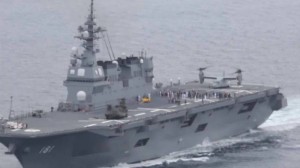 The MV-22 Program Office is on an emotional roller-coaster.
The MV-22 Program Office is on an emotional roller-coaster.
Early this summer, things were going well. The Pentagon inked a big Osprey block-buy. Sales to Japan and Israel are anticipated. A big Japanese deployment is underway. But then the Program looses two airframes in two months and gets hit with an IG report trenchant enough to be classified.
That’s one tough summer.
Like it or not, the MV-22 is going into the USMC inventory, where the tilt-rotor’s speed and relative agility are popular. Combat operations did wonders in securing the platform, relieving the airframe of constant public nit-picking–and it gave MV-22 managers some breathing room to iron out initial operating foibles.
But in the era of tight budgets, all platforms are vulnerable. And now that combat in Iraq and Afghanistan is winding down, folks are asking for performance assessments–and questioning things about the MV-22’s operational costs and mission readiness. For MV-22 advocates, that is never a good thing. And apparently the results are a little worse than expected, since Defense News reporter James Sanborn revealed that the IG is involved and the report they are generating will be classified. According to his story:
The Defense Department inspector general’s audit will determine whether the Osprey’s performance “meets mission capability rate requirements, as well as how the frequency of repairs and the replacement of supply parts” affects its mission readiness, officials with the IG’s office wrote in their August newsletter. It is not clear who requested the audit, but its results will be classified, according to Bridget Ann Serchak, the IG’s chief of public affairs. She declined to provide further details. However, the process did encompass several years’ worth of data. A memorandum from the IG, dated January 2012, indicates the audit was to include V-22 operations from Oct. 1 2008 through Sept. 30, 2011.
That’s not good.
Classifying the whole thing isn’t good either. Hopefully nothing illegal happened here. (And even if nothing bad happened, you must feel some measure of sympathy for the folks in the MV-22 offices who have to grapple with the IG folks, because, in a combat zone, there are all kinds of factors that “distort” operational and availability data.) At best, the information the IG dug up is going to be debatable, and something pesky civilians can use to vex the program. So while I am not a fan of classification to limit debate, I can understand the urge to do so (and with Foreign Military Sales underway, I can appreciate the sensitivity there as well). But overall, classification of the IG report is not exactly a sign of confidence. 
Outside of the IG report, the airframe itself hasn’t been doing itself any favors lately, with two aircraft totaled in the space of little more than two months.
Gretel Kovach, reporting from the UT San Diego, did a great job reporting on the most recent MV-22 crash (a hard landing and fire in Nevada this month), catching that the USMC had quietly written off another MV-22 in a earlier June mishap:
The Naval Safety Center determined the [first] aircraft was destroyed during “reduced visibility landing practice,” according to a summary of the “Class A mishaps” on the center’s web site. An estimate of the cost in property damages was not listed.
Class A mishaps are the most serious, involving at least $1 million in damages [ed–isn’t it $2 million now?], a fatality or permanent total disability.
The only other MV-22 Class A mishap reported by the Navy this year involved Marine Medium Tiltrotor Squadron 365, out of Jacksonville, N.C. An Osprey was destroyed June 21 after one in a pair of tiltrotors landed and set the grass on fire.
The fire spread to the fuselage, causing more than $63 million in damages to the aircraft — a total loss, the Naval Safety Center reported.
These twin mishaps suggest that the USMC is still having a hard time managing the Osprey/ground interface. A hard landing in a tough training exercise is one thing–but we shouldn’t be loosing these aircraft to…LZ grassfires?!! Surely, by now, operators have enough experience managing the Osprey’s hot n’ heavy downdraft to avoid such losses. (Some Osprey grassfire background is here and an old op-ed of mine is here.)
(I would, as an aside, commend the West Coast PR person who handled the Nevada mishap. Nothing was hidden, the spokesperson made a very good effort in highlighting the positive-no fatalities, the crew walked away from the aircraft, etc.. That is in stark contrast to the minimal statements from the East Coast accident).
Loosing an airframe is never good, but these losses come at a very sensitive period for the program. With Ospreys in Okinawa and Japan on the verge of buying a brace of Osprey for rapid small-force theater lift, the stakes are pretty high. Failure now will not only damage the program, but will carry serious international ramifications in the Pacific.
If there is a time for the MV-22 Osprey to demonstrate that the troubled tiltrotor’s initial hiccups are behind it, the moment is now. And the place? Probably Syria.
